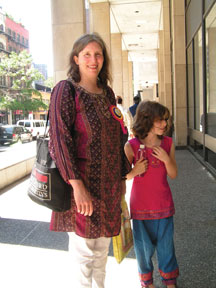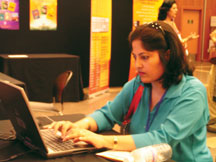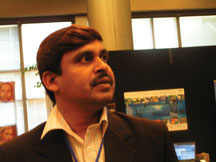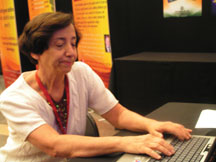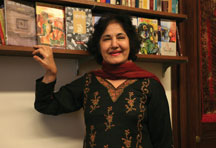Life
Exporting Hindi

This Made in India product is finding its way into many countries.
Pankaj Udhas, the famous ghazal singer, was once rushing to the airport in New York. Anxiously he urged the taxi driver in English, “Can you please push the speed a little, because I’m very late for my flight?”
“Zara Ahista Chal” (Go a little slow) came the retort in Hindi, playing on one of Udhas’s most famous lyrics. “I was amazed that this American knew this very old ghazal of mine,” recalled Udhas recently. “I asked him how he knew Hindi and he told me he was from Afghanistan, and not only did he speak Hindi, but he loved Hindi songs.” It seems to echo the story of Hindi worldwide. Ahista, ahista chal ke Hindi is penetrating far flung parts of the world, often on the wings of Bollywood, yoga studios or Indian restaurants. On a recent weekend you would have found more Hindi experts on one street block of Manhattan than in any full-fledged university in India. The occasion was the 8th World Hindi Conference, which brought together over 1,000 delegates from all parts of the world to discuss the future of India’s national language. The convention attracted scholars and delegates from China, Korea, Japan, Italy, Uzbekistan and the Caribbean. The conference, organized by the Indian External Ministry in collaboration with Bharatiya Vidya Bhavan, was inaugurated at the United Nations, giving the event a measure of pomp and circumstance. And some political calculus. One of its objectives is to secure the designation of Hindi as an official language of the United Nations, which presently only recognizes English, French, Chinese, Russian, Spanish and Arabic.
That may prove to be a tall order, even though Hindi is the second most widely spoken language on the planet after Mandarin, because it will require support from two-thirds of the members of the General Assembly. Meanwhile, Hindi is making inroads slowly into the many countries where Indian immigrants have settled. According to Donatella Dolcini, a professor of Hindi and Indian studies at the University of Milan, Italy, which has a sizable Indian population, mostly into farming, Milan alone has seven Hindi schools. Most of her students are Italian, learning Hindi either because they are intrigued by Indian culture or because they hope to get jobs in India. As India embraces the global economy, many Italian companies are entering India, creating a demand for bilingual Italian workers. At the same time, Indians have settled in far-flung countries, many migrating for the second time, and Hindi is something they have carried with them on these migrations. While their parents had migrated from India to Suriname, Devanand Bhageloe and his sister Shama Yipat-Kanhaisingh moved from Suriname to Rotterdam, Holland. Hindi was something they preserved through these migrations, and today their children speak fluent Hindi. Shama, who runs a yoga center and Hindi classes in Rotterdam, says it’s important to maintain the culture and language: “Jo haath mein hain so saath mein hain (what you have in your hand is always with you).” Shashi Padha, a Hindi teacher from India, now lives in Connecticut and Virginia and teaches Hindi in the U.S., even as she helps to bring up her grandchildren, as her sons are settled here. She taught Hindi at the University of North Carolina in Chapel Hill.
Her classes generally draw about 30 students, of which 60 percent are of Indian origin, children who have grown up here and want to learn their mother tongue. The other students are a mix, including Caucasians, Japanese, Koreans and Mexicans. Often the Indian students are of Gujarati or Tamilian heritage, who want to learn Hindi besides their regional language. Padha’s classes are also televised for students learning from home. She says, “We start with the alphabet and learning grammar. There are no shortcuts.” Does she find an audience for Hindi books, poetry and literature in the U.S.? Padha says there is an active interest in North Carolina, where kavi sammelans are held regularly in people’s homes: “I was so happy and surprised to see that people are working hard to spread Indian culture and Indian literature.” She has not yet found similar gatherings in Connecticut. Susham Bedi, professor of Hindi at Columbia University, however, does not see much interest in Hindi literature amongst immigrants. She says, “There is a very limited readership and interest. The problem is people connect Hindi with Bollywood or religion, not literature.” She feels that the formation of Hindi book clubs in communities would nurture readership and a greater appreciation of Hindi literature. Bedi, who is also a teacher trainer for American Council on the Teaching of Foreign Languages, says that currently Hindi is taught at about 100 U.S. colleges and universities, but most of them are three year courses and do not emphasize literature. The South Asia Institute at the University of Austin offers the country’s only four year undergraduate Hindi and Urdu program starting in Fall 2007 under a $700,000 grant from the Institute of International Education. There is growing recognition within U.S. academe of the importance of strengthening Hindi instruction. According to Bedi, several South Asian languages, such as Hindi, Urdu and Bengali have been classified as critical languages under President Bush’s National Security Language Initiative, with the goal to increase the number of advanced level speakers in these languages for business, security, diplomacy and cultural reasons. Presently South Asian language instruction is offered principally at the college and university level, but Bedi believes it is impossible to gain a high level of proficiency in any foreign language by studying it for one or two years at college. She wants Hindi language instruction to be offered at the K-12 level. Bedi is chairing an effort in collaboration with her counterparts at the University of Pennsylvania, Harvard University, University of Texas, University of California, Los Angeles, Yale University and Cornell University to propose curriculum and national standards for K-12 and post secondary Hindi instruction. While this plan to offer Hindi instruction in schools is still at the proposal level, Bedi says, some schools in Texas are already offering Hindi in high school. Surprisingly, most students are non-Indian. She says, “It’s the business world which will be requiring Hindi speakers now.” The far larger group of potential Hindi students are second generation Americans who trace their roots to India. Presently, community schools are held on weekends in different venues in many parts of the country to serve the needs of this population. Bedi learnt of Hindi classes for over 200 students held every Sunday in a large $17 million community center funded by Indian donors in San Jose, Calif.
Bharatiya Vidya Bhavan has established Hindi learning centers in the United Kingdom, Mexico and Portugal, as well as the United States. Dr. P. Jayaraman, director of the New York branch, has seen the slow and steady growth of Hindi in the U.S. He says, “The Bhavan has been holding Hindi classes since 1983. In the beginning there used to be 10 to 15 students; now we have about 80 to a hundred.” “Parents have started realizing the importance of Hindi and some also attend the classes with their children,” says Jayaraman. “Americans learn Hindi for a number of reasons: Globalization; outsourcing of businesses; business links with India; inter marriages; liking for Hindi movies and songs; interest in Indian culture, linguistic interest; and travel to India.” The Bhavan also conducts music and dance classes as well as cultural programming in Hindi. An upcoming cultural festival will celebrate the 60th anniversary of India’s independence and the centenary of the celebrated poet Dr. Harivansh Rai Bachchan, the late father of Amitabh Bachchan. The famous son will recite the father’s poems at Avery Fisher Hall at Lincoln Center. Many second generation Indian Americans are embracing their language and culture. Most are not fluent in Hindi and are sending their own children to learn Indian languages and culture at community organizations, such as the Young Indian Culture Center in Long Island. Others are trying to produce Hindi learning DVDs, such as Baby Hindustani and MeeraMausi language learning tapes, created especially for children growing up here by mothers who themselves have grown up in America. Ironically, as Hindi is building a stronger appeal abroad, it is beginning to flag in the home country among the middle and upper classes. Dr. Anuradha Agnihotri, a teacher educator from Chandigarh, says that while Hindi is the national language, most professional jobs demand English proficiency. She says of the double standards: “I must tell you that Hindi is a very local language. You want to go in an auto-rickshaw or buy your groceries you will talk in Hindi. It’s a common man’s language and everyone is comfortable in it.
“Yet parents tend to send their children to English medium schools. Though they all talk in Hindi, Hindi medium education is taboo for them.” Agnihotri, who herself started in a Hindi medium school, shifted to the English medium in high school and found quite a bias: She recalled the students taunting her as BTM – or behnji turned modern. The teachers there did not even know the Hindi term for a word like photo synthesis. She admits, “Hindi is a difficult language, but I love my language.” Hindi is now entering the IT age with software and web-based programs to learn Hindi or to conduct office and business work in Hindi. The Indian government has established an initiative “Technology Development for Indian Languages” through which it offers free software, fonts, spell checker, dictionary, transliterator and other tools for almost a dozen Indian languages, including Hindi (http://www.ildc.in). The Center for Development of Advanced Computing (CDAC) in Pune has developed software to supports 12 languages. Leap Office 2000, for instance, is an office solution in 22 Indian languages. Chitrankan is the first optical recognition system for Indian languages. The Center also offers Hindi speaker recognition as well as language learning software. While these products are targeted for the Indian market, they also have use for Diasporic communities: “There are 15 million users of these tools in India, but they are also being used in Suriname and Fiji,” says Karimullah Shaik of CDAC. “There is teaching software not only in English but also in Tamil and other regional languages, so you can use those as your medium of instruction.” The software MANTRA (Machine Assisted Translation Tool), translates English text into Hindi in real time, allowing, for instance, a child in California to communicate with a grandparent in India in Telegu, Bengali or Hindi. Anurag Chakradhar, an online specialist and director of a Sydney based advertising agency in Australia, is avidly following the future of Hindi on the web. “Anyone working on creating online content in Hindi will be faced by a myriad accessibility and usability issues,” he says. “They will benefit from existing knowledge but it is certain that a new knowledge base will be needed to cater to the specific needs of Hindi content and Hindi web users. A call must be made to the Hindi speaking web specialists worldwide to start looking at the Internet with Hindi glasses on.” However, even though Hindi is the second most popular spoken language in the world, it barely registers on the Web. Instead, it Bollywood films that are Hindi’s most powerful and very unlikely ally! These movies have found fans all over the world and in the strangest places. Professor Tomio Mizokami from Japan, speaks Hindi like a native and has written a book Hindi Filmon Ke Lok Priya Geet (1951-1980) in which he’s translated over 300 classic Hindi film songs into Japanese. How did he get into Hindi and that too 50 years ago? As a high school student in Kobe, which had a sizable Indian community, he recalls following two beautiful Indian women in saris. He saw them holding some books in a strange script and immediately got hooked to this language. In college he learnt Hindi and in 1962 went to study Hindi in India and has been back every year since. “Most of my students weren’t that motivated in learning Hindi, so I wondered how to motivate them,” says Mizokami. He settled on Indian film music, which his students love. Now they are asking him to translate the latest film songs, though the old Raj Kapoor songs sung by Mukesh are still his favorite. The fascination with Bollywood has prompted numerous non-Indians to learn Hindi. Take a look at the website Bollywhat.com to understand the passion of westerners for Bollywood movies. This site created by non-Indians is almost a primer on Hindi movies for non-Hindi speakers: the movie plots are dissected, traditions in films explained and entire lyrics translated from Hindi to English. For this frenzy, we have stars like Shah Rukh Khan, Salman Khan and Vivek Oberoi to thank!
Carolyn Lengel, a text book editor in New York and her young daughter Harriet are both taking Hindi classes. “We got into Hindi through Bollywood. We are big fans of Bollywood movies. We love Amitabh, Amir Khan and Ram Gopal Verma movies,” says Langel. “I wanted to understand the movies better. I think Bollywood is becoming more and more popular in the U.S. even among people who are not Indians. There are lots of people in my class learning Hindi for the same reason. You want to know what they are saying. You want to not have to rely on subtitles, which are not always very good.” The same motivation is driving many second generation Indian Americans too. When Anil Prabha Kumar, a professor at William Paterson College in New Jersey, asks her young Indian American students for their reasons for studying Hindi, the most common response, “We want to understand Hindi films without the subtitles.” Others say they want to be able to speak with their cousins in India, who mock them, because they can’t speak Hindi, while still others want to write letters to their grandparents. Kumar also uses Bollywood to get her students to understand the language and teaches them grammar through film music and cinema. Who would have believed it, but Shah Rukh Khan’s Main Hoon Na is a virtual learning tool for Hindi tenses! She reserves the last 15 minutes of the class for Hindi movie viewing – and of course, not a single student wants to leave or miss the class! Seema Khurana, who teaches Hindi at Yale University, explains how she uses films and music to teach her students the language. She finds that hit songs like “Kabhi Kabhi” are great for lessons in teaching passive voice. At the same time, she points out, Hindi films and songs do teach much more than just the language; they also familiarize students with the social and political climate of the country. For those who complain that Hindi films have changed since the 1950’s, that the dialogues no longer have the same lilt as the classic films, Gulzar, who has some superb movies to his credit, has this to say; “Films are a hreflection of society and if there is a weakness or good point about it, you will have to stand in front of the mirror and look at yourself to understand the changes.” A popular Hindi film song, which Pankaj Udhas is always asked to sing, no matter where he goes in the Diaspora, strums the heartstrings of immigrants, from the Middle East to the US to Tokyo. Bade dino ke baad, Hum bewatno ko yaad. Watan ki mitti ayee hai. Chithi ayi hai, ayi hai, chithi ayi hai. Chithi ayi hai, watan se chithi ayi hai. Upar mera naam likha hai, Andhar ye paigam likha hai. O pardes ko jaane wale, laut ke phir na ane wale. Saat samandar par gaya tu, Hum ko zinda maar gaya tu. Khoon ke rishte tod gaya tu, Aankh mein ansoo chhod gaya tu. Kum khate hain, kum sote hain, Bahut ziyada hum rote hain. The song goes on to chronicle joyous festivals spent without the loved one, of dark, lonely Diwalis and begs the traveler to forget about making money and return home to his loved ones. This beautiful ballad of separation and loss is impossible to fully appreciate or understand in English: the deep embedded grief of parents left behind, the lure of the homeland for the ones who have lost it. The word “exile” cannot begin to capture the full pathos and potency of “bewatan.” Hindi articulates these emotions with poignancy and power, and thousands of immigrants gather to share the rhythms, savor the lyrics and understand that they are not alone in their loss, that there are many many more wanderers bound by the umbilical cord of Hindi to a far-away home and a disappeared life. |

